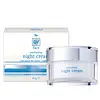What's inside
What's inside
 Key Ingredients
Key Ingredients

 Benefits
Benefits

 Concerns
Concerns

 Ingredients Side-by-side
Ingredients Side-by-side

Aloe Barbadensis Leaf Juice
Skin ConditioningWater
Skin ConditioningPentylene Glycol
Skin ConditioningPropylene Glycol
HumectantPropylheptyl Caprylate
EmollientEthylhexyl Stearate
EmollientGlyceryl Stearate Citrate
EmollientHydrogenated Polydecene
EmollientCetearyl Alcohol
EmollientGlyceryl Stearate
EmollientEthylhexyl Methoxycinnamate
UV AbsorberGlycerin
HumectantDecyl Oleate
EmollientPolyglyceryl-6 Stearate
EmollientPersea Gratissima Oil
Skin ConditioningVitis Vinifera Seed Oil
EmollientTocopherol
AntioxidantHelianthus Annuus Seed Oil
EmollientRoyal Jelly
Retinyl Palmitate
Skin ConditioningXanthan Gum
EmulsifyingTetrasodium Glutamate Diacetate
Polyacrylate Crosspolymer-6
Emulsion StabilisingAlcohol Denat.
AntimicrobialT-Butyl Alcohol
PerfumingDimethicone
EmollientSodium Lactate
BufferingPalmitic Acid
EmollientStearic Acid
CleansingPolyglyceryl-6 Behenate
Emulsion StabilisingPropolis Cera
AntiseborrhoeicSodium Hydroxide
BufferingHydrogenated Palm Glycerides Citrate
EmollientParfum
MaskingLinalool
PerfumingAlpha-Isomethyl Ionone
PerfumingHydroxycitronellal
PerfumingLimonene
PerfumingHexyl Cinnamal
PerfumingCitronellol
PerfumingBenzyl Alcohol
PerfumingBenzyl Benzoate
AntimicrobialAloe Barbadensis Leaf Juice, Water, Pentylene Glycol, Propylene Glycol, Propylheptyl Caprylate, Ethylhexyl Stearate, Glyceryl Stearate Citrate, Hydrogenated Polydecene, Cetearyl Alcohol, Glyceryl Stearate, Ethylhexyl Methoxycinnamate, Glycerin, Decyl Oleate, Polyglyceryl-6 Stearate, Persea Gratissima Oil, Vitis Vinifera Seed Oil, Tocopherol, Helianthus Annuus Seed Oil, Royal Jelly, Retinyl Palmitate, Xanthan Gum, Tetrasodium Glutamate Diacetate, Polyacrylate Crosspolymer-6, Alcohol Denat., T-Butyl Alcohol, Dimethicone, Sodium Lactate, Palmitic Acid, Stearic Acid, Polyglyceryl-6 Behenate, Propolis Cera, Sodium Hydroxide, Hydrogenated Palm Glycerides Citrate, Parfum, Linalool, Alpha-Isomethyl Ionone, Hydroxycitronellal, Limonene, Hexyl Cinnamal, Citronellol, Benzyl Alcohol, Benzyl Benzoate
Cyclopentasiloxane
EmollientGlycerin
HumectantCarthamus Tinctorius Seed Oil
MaskingPetrolatum
EmollientParaffinum Liquidum
EmollientGlyceryl Stearate
EmollientPEG-100 Stearate
Cetearyl Alcohol
EmollientNiacinamide
SmoothingDimethicone
EmollientMethylparaben
PreservativePropylparaben
PreservativeSodium Polyacrylate
AbsorbentTocopherol
AntioxidantDichlorobenzyl Alcohol
AntimicrobialCitric Acid
BufferingIngredients Explained
These ingredients are found in both products.
Ingredients higher up in an ingredient list are typically present in a larger amount.
Cetearyl alcohol is a mixture of two fatty alcohols: cetyl alcohol and stearyl alcohol. It is mainly used as an emulsifier. Emulsifiers help prevent the separation of oils and products. Due to its composition, it can also be used to thicken a product or help create foam.
Cetearyl alcohol is an emollient. Emollients help soothe and hydrate the skin by trapping moisture.
Studies show Cetearyl alcohol is non-toxic and non-irritating. The FDA allows products labeled "alcohol-free" to have fatty alcohols.
This ingredient is usually derived from plant oils such as palm, vegetable, or coconut oils. There is debate on whether this ingredient will cause acne.
Due to the fatty acid base, this ingredient may not be Malassezia folliculitis safe.
Learn more about Cetearyl AlcoholDimethicone is a type of synthetic silicone created from natural materials such as quartz.
What it does:
Dimethicone comes in different viscosities:
Depending on the viscosity, dimethicone has different properties.
Ingredients lists don't always show which type is used, so we recommend reaching out to the brand if you have questions about the viscosity.
This ingredient is unlikely to cause irritation because it does not get absorbed into skin. However, people with silicone allergies should be careful about using this ingredient.
Note: Dimethicone may contribute to pilling. This is because it is not oil or water soluble, so pilling may occur when layered with products. When mixed with heavy oils in a formula, the outcome is also quite greasy.
Learn more about DimethiconeGlycerin is already naturally found in your skin. It helps moisturize and protect your skin.
A study from 2016 found glycerin to be more effective as a humectant than AHAs and hyaluronic acid.
As a humectant, it helps the skin stay hydrated by pulling moisture to your skin. The low molecular weight of glycerin allows it to pull moisture into the deeper layers of your skin.
Hydrated skin improves your skin barrier; Your skin barrier helps protect against irritants and bacteria.
Glycerin has also been found to have antimicrobial and antiviral properties. Due to these properties, glycerin is often used in wound and burn treatments.
In cosmetics, glycerin is usually derived from plants such as soybean or palm. However, it can also be sourced from animals, such as tallow or animal fat.
This ingredient is organic, colorless, odorless, and non-toxic.
Glycerin is the name for this ingredient in American English. British English uses Glycerol/Glycerine.
Learn more about GlycerinGlyceryl Stearate is a mix of glycerin and stearic acid.
It is used to stabilize the mixing of water and oil ingredients. By preventing these ingredients from separating, it can help elongate shelf life. It can also help thicken the product's texture.
As an emollient, it helps soften skin and supports barrier-replenishing ingredients.
In cosmetics, Glyceryl Stearate is often made from vegetable oils or synthetically produced.
This ingredient may not be fungal-acne safe
Fun fact: The human body also creates Glyceryl Stearate naturally.
Learn more about Glyceryl StearateTocopherol (also known as Vitamin E) is a common antioxidant used to help protect the skin from free-radicals and strengthen the skin barrier. It's also fat soluble - this means our skin is great at absorbing it.
Vitamin E also helps keep your natural skin lipids healthy. Your lipid skin barrier naturally consists of lipids, ceramides, and fatty acids. Vitamin E offers extra protection for your skin’s lipid barrier, keeping your skin healthy and nourished.
Another benefit is a bit of UV protection. Vitamin E helps reduce the damage caused by UVB rays. (It should not replace your sunscreen). Combining it with Vitamin C can decrease sunburned cells and hyperpigmentation after UV exposure.
You might have noticed Vitamin E + C often paired together. This is because it is great at stabilizing Vitamin C. Using the two together helps increase the effectiveness of both ingredients.
There are often claims that Vitamin E can reduce/prevent scarring, but these claims haven't been confirmed by scientific research.
Learn more about Tocopherol